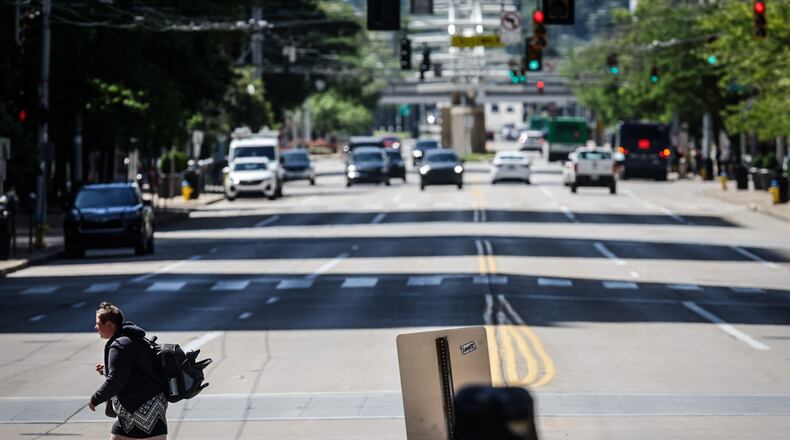These and other “critical” infrastructure investments are supposed to help build a “Greater Downtown Innovation District” that links assets and connects people to employment, educational and economic opportunities.
“The city is researching and applying for any infrastructure grant that can advance the city,” said Joe Weinel, Dayton’s chief engineer.
Post-WWII roadway projects
Dayton has submitted an application seeking nearly $16.8 million in federal funding from the federal Rebuilding American Infrastructure with Sustainability and Equity (RAISE) discretionary grant program.
The U.S. Department of Transportation has billions of dollars available for projects that have a significant local or regional impact. Awards are expected to be announced next month.
Credit: Jim Noelker
Credit: Jim Noelker
From the late 1940s through the late 1970s, Dayton widened many major corridors to try to move as many vehicles as possible through the city as quickly as possible, to improve the travel convenience of an auto-oriented suburban vision for the region, according to documents that were submitted as part of the city’s RAISE application.
The road widenings split and compromised “neighborhood relationships” and created dangerous conditions for pedestrians, cyclists and transit riders, the application states.
“Much of the attractiveness and beauty of iconic pre-war Dayton thoroughfares and corridors were disfigured as tree canopies were removed and replaced with a forest of multiple overhead cables, wires, proliferation of traffic and automobile-oriented suburban-style signage created visual chaos,” the application states.
The city says it wants to make infrastructure upgrades that enhance safety and improve traffic patterns.
Dayton says if its RAISE funding request is approved, it would give the city five to six rounds of transportation funding in one funding cycle, which would accelerate efforts to improve local infrastructure in ways that promote the local creative urban economy.
Patterson Boulevard changes
The city proposes using more than $5 million of RAISE money to make some big changes to Patterson Boulevard, including extending the esplanade from where it currently ends on Jefferson Street, down to Stewart Street.
The project would extend the existing riverwalk along Patterson Boulevard with a wide walk or multi-use path and tree lawn with trees and ornamental lights, said Weinel, Dayton’s chief engineer.
The city wants to remove a northbound traffic lane on Patterson from South Main Street to Veterans Parkway, by the Stewart Street bridge.
Weinel said there are currently three northbound lanes, but the curb lane would be eliminated and replaced with a tree lawn and a wide walk or multi-use path.
The city also proposes to remove a southbound traffic lane on Patterson Boulevard roughly from Apple Street to Stewart Street.
Two southbound lanes will remain, but the third would be replaced with a wider walk and tree lawn.
West Third Street
Using RAISE funds, the city also proposes to reduce the number of lanes of travel on West Third Street from five to three from Broadway Street to Abbey Avenue. A protected two-way cycle track also would be added.
West Third Street’s travel lanes were shrunk from five to three in 2010 between Edwin C. Moses Boulevard and Broadway Street, which is the Wright Dunbar historic business district.
Credit: JIM NOELKER
Credit: JIM NOELKER
The road diet helped slow traffic, created new on-street parking and improved the pedestrian experience, benefitting shops in business district, according to the city.
The city also proposes resurfacing West Third Street, between Broadway and Abbey streets, replacing Greater Dayton RTA poles and consolidating them with street light poles and moving an RTA feeder cable underground.
Main, Stewart, Washington
Dayton proposes to install curb extensions on Main Street at 15 street corners in downtown between Monument Avenue and Sixth Street.
The plan also calls for putting in a pedestrian crosswalk on Main at the Private Fair monument, which is the tall monument and island in the middle of the roadway at the north end of downtown, near the river.
Pedestrian island crossings are proposed for South Main Street at Jasper and Frank streets, near the Montgomery County Fairgrounds. High visibility crosswalks could be placed on Main Street by Miami Valley Hospital’s emergency room entrance.
The city wants to add curb extensions on a 0.6-mile section of Stewart Street, between Edwin C. Moses Boulevard and Campbell Street in West Dayton, to calm traffic and create defined parking spaces.
Washington Street also could be realigned at the Germantown Street intersection in West Dayton, which is near Mound Street Academy and the Dayton Police Department’s west district headquarters.
The city wants to put speed tables in front of the David H. Ponitz Career Technology Center and Chaminade Julienne Catholic High School, which are both located on Washington Street.
The proposal also calls for multiuse paths on the southern sides of Stewart and Washington streets.
The city says it would install ornamental street lights on most of these corridors, plus pedestrian lighting on some roads.
The RAISE grant is extremely competitive, but Dayton has a strong application, city staff said. If approved, this infrastructure work would likely start in 2027 and be complete by 2029.
About the Author




